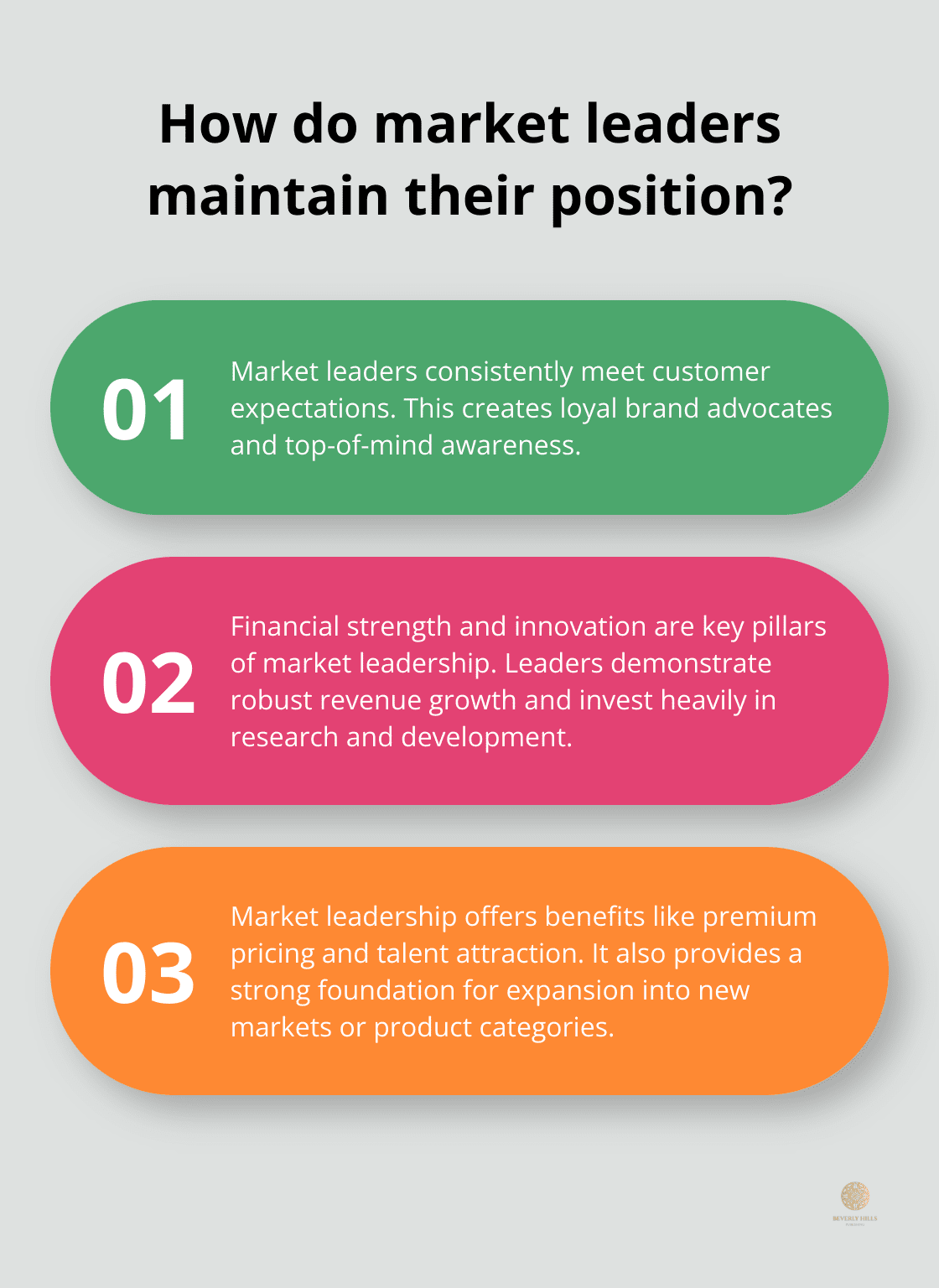At Beverly Hills Publishing, we understand the challenges market leaders face in maintaining their position. Staying at the top requires a combination of innovation, adaptability, and effective marketing strategies.
In this post, we’ll explore proven marketing strategies for market leaders to help you solidify your position and drive continued growth. We’ll also address common obstacles and provide practical tips for overcoming them in today’s competitive landscape.
What Defines Market Leadership?
The Essence of Market Leadership
Market leadership transcends mere market share dominance. It embodies the ability to set industry standards, drive innovation, and consistently deliver value to customers. Companies that achieve this status shape their industries and influence consumer behavior significantly.
Key Pillars of Market Leadership
Several core elements contribute to market leadership:
- Customer Satisfaction: Market leaders consistently meet and exceed customer expectations, creating loyal brand advocates.
- Financial Strength: Leaders demonstrate robust revenue growth and profitability that outpaces competitors.
- Innovation: Top companies invest heavily in research and development, constantly pushing industry boundaries (rather than settling for the status quo).
The Impact of Brand Recognition
Brand recognition plays a pivotal role in market leadership. When consumers think of a particular product or service, the market leader’s brand often comes to mind first. This top-of-mind awareness provides a significant advantage in attracting and retaining customers.

For instance, Amazon’s strong brand recognition in online retail has helped maintain its position as an e-commerce leader, despite increasing competition.
The Importance of Maintaining Market Leadership
Maintaining market leadership offers numerous benefits:
- Premium Pricing: Leaders can often command higher prices for their products or services.
- Talent Attraction: Top talent is drawn to market-leading companies.
- Supplier Negotiations: Leaders can often secure better terms with suppliers.
- Economies of Scale: Market leaders benefit from cost advantages due to their size and efficiency.
- Growth Platform: Leadership provides a strong foundation for expansion into new markets or product categories.
Navigating the Challenges of Leadership
The path to maintaining market leadership is fraught with challenges. The business landscape evolves constantly, with new competitors and disruptive technologies emerging regularly. Market leaders must remain vigilant and adaptable to stay ahead.
One significant hurdle is avoiding complacency. Success can breed a false sense of security, leading companies to stagnate instead of continuing to innovate and improve.
To address these challenges and solidify their position, market leaders must employ effective marketing strategies. The next section will explore these strategies in detail, providing actionable insights for companies aiming to maintain their leadership position.
Winning Marketing Strategies for Market Leaders
Innovate Continuously
Microsoft’s marketing methods are a great example of how to make a successful plan. Understanding your customers is the first step in crafting a successful marketing strategy. Innovation forms the foundation of market leadership. Companies that fail to innovate quickly find themselves overtaken by more agile competitors. Netflix exemplifies this principle, transforming from a DVD rental service to a streaming giant and now a major content producer. This constant evolution keeps them at the forefront of the entertainment industry.

To foster innovation, companies should allocate resources to research and development. Google’s practice of allowing employees to spend 20% of their time on personal projects has led to the creation of products like Gmail and Google News.
Leverage Customer Feedback
Customers provide an invaluable source of insights. Companies should implement robust feedback systems to capture opinions, preferences, and pain points. Amazon’s product review system and recommendation engine demonstrate how customer data can drive business decisions and improve user experience.
Net Promoter Score (NPS) surveys effectively gauge customer loyalty. Bain research at one bank showed that employees with the highest employee Net Promoter Scores generated customer Net Promoter Scores that were more than three times higher than those with the lowest employee NPS.
Embrace Digital Transformation
In today’s digital-first world, market leaders must leverage technology to stay ahead. This involves more than just maintaining a website or social media presence. It requires the use of data analytics, artificial intelligence, and machine learning to optimize marketing efforts and personalize customer experiences.
Starbucks utilizes its mobile app to collect data on customer preferences and buying habits. This information powers personalized marketing campaigns and helps the company make informed decisions about new product offerings.
Build a Strong, Consistent Brand Identity
A brand represents a company’s most valuable asset. It differentiates a company from competitors and creates an emotional connection with customers. Consistency plays a key role in brand building. Companies should ensure their brand message, visual identity, and values remain uniform across all touchpoints.
Apple masters brand consistency. From their minimalist product design to their sleek retail stores, every aspect of the Apple experience reinforces their brand identity of innovation and premium quality.
Adapt to Market Changes
Market leaders must remain agile and responsive to shifts in consumer behavior, technological advancements, and competitive landscapes. This adaptability allows companies to capitalize on new opportunities and mitigate potential threats.
For instance, when the COVID-19 pandemic hit, many businesses quickly pivoted to online operations and contactless services. Those who adapted swiftly (like restaurants implementing robust delivery systems) often outperformed their less flexible competitors.
The ability to anticipate and respond to market changes separates true market leaders from the rest. As we explore in the next section, maintaining this leadership position comes with its own set of challenges that require strategic navigation.
Navigating Market Leadership Challenges
Anticipate Competitive Moves
Market leaders must remain alert about emerging competitors and potential disruptors. This requires a proactive approach to market intelligence. Companies should invest in competitive analysis tools and allocate resources to monitor industry trends.

Walmart’s acquisition of Jet.com in 2016 for approximately $3 billion exemplifies a strategic move to compete with Amazon in e-commerce. This proactive step helped Walmart strengthen its online presence and defend its market position.
Embrace Agile Decision-Making
In rapidly changing markets, the ability to make quick, data-driven decisions is essential. Companies should implement agile methodologies not just in product development, but across all business functions.
Zara, the fast-fashion retailer, exemplifies this approach. Their supply chain can design, produce, and deliver new clothing items to stores in as little as 15 days. This agility allows them to respond quickly to fashion trends and maintain their market leadership.
Exceed Customer Expectations
Market leaders can’t afford to rest on their laurels when it comes to customer satisfaction. They must continually raise the bar on customer experience.
Amazon’s introduction of same-day delivery and its constant expansion of Prime benefits demonstrate how market leaders can stay ahead by consistently surpassing customer expectations. A 2021 report by Statista showed that Amazon Prime had over 200 million subscribers worldwide (a testament to its success in customer retention through continuous improvement).
Balance Short-Term Results and Long-Term Vision
While quarterly results matter, market leaders must also invest in long-term strategies that may not yield immediate returns. This balance is critical for sustainable leadership.
Microsoft’s investment in cloud computing through Azure is a prime example. Despite initial losses, Microsoft’s commitment to this long-term strategy has paid off. In 2022, Microsoft Azure reached a market share of 23% in the cloud infrastructure and platform services market (second only to Amazon Web Services).
Cultivate Innovation Culture
To maintain market leadership, companies must foster a culture of innovation throughout their organization. This involves encouraging risk-taking, rewarding creative thinking, and providing resources for experimentation.
Google’s practice of allowing employees to spend 20% of their time on personal projects has led to the creation of successful products like Gmail and Google News. This approach not only drives innovation but also helps retain top talent who value the opportunity to pursue their ideas.
Final Thoughts
Market leadership demands a multifaceted approach that combines innovation, adaptability, and effective marketing strategies. Successful market leaders consistently innovate, leverage customer feedback, embrace digital transformation, and build strong brand identities. They anticipate competitive moves, make agile decisions, exceed customer expectations, and balance short-term results with long-term vision.

Marketing strategies for market leaders focus on continuous improvement and staying ahead of the curve. This involves investment in research and development, implementation of robust feedback systems, use of data analytics, and maintenance of a consistent brand message across all touchpoints. Companies must continually assess and improve their marketing efforts to stay ahead in today’s competitive landscape.
We at Beverly Hills Publishing understand the challenges market leaders face in maintaining their position. Our integrated approach to publishing and marketing helps authors establish themselves as leading authorities in their industries. We equip authors to elevate their visibility and emerge as industry leaders with a commanding media presence (through a combination of groundbreaking publishing with strategic branding and marketing).















































































































































































































































